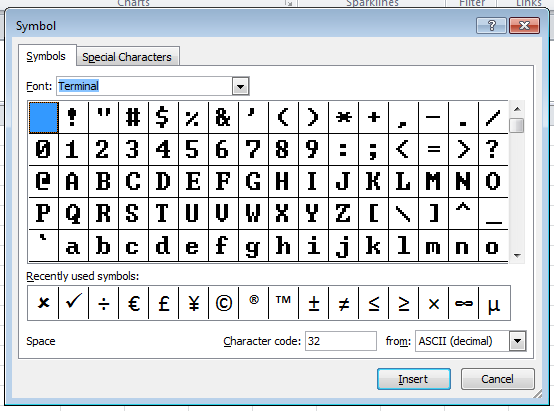The special character will appear in the Find what text box as a caret code. The caret code for the em dash appears in figure 12, below. Enter the replacement character in the Replace with text box. (Repeat step 5 and step 6 if you are replacing the existing character with one of the seven available in this dialog box. The caret code for the. The FIND formula is used to return the position of a substring or special character within a text string. The Formula for the FIND function is as follows: The first two arguments are mandatory, the last one is optional. Findtext (required)- the substring or character you are looking to find.
Alt codes for symbols and special characters If you have a numeric keypad, you can use Alt codes to get symbols and special characters. For ASCII characters, hold the Alt key, then type the code. For example, Alt + 171 will insert the “one-half” symbol. Click on the Special Characters tab. Click on the special character you wish to use. Click on the Insert button to use the special character in the selected cell. Once inserted the Cancel button will change to the Close button, when you are done, click Close to return to the spreadsheet. FIND Formula in Excel The FIND formula is used to return the position of a substring or special character within a text string. The Formula for the FIND function is as follows: The first two arguments are mandatory, the last one is optional.
Inserting symbols and unusual characters to your document is easy with Office 2011 for Mac. Symbols for foreign languages, math and science, currency, and so on, are quickly accessible in Office 2011 for Mac.

Just position your insertion cursor (the blinking vertical bar) where you want the symbol inserted in your document and then use one of the following tools to browse the symbols in your Mac’s font collections:
The Symbols tab of the Media browser is a quick, easy way to get at the most popular symbols.
Record screen on mac yosemite. In Microsoft Word, you can choose Insert→Symbol→Advanced Symbol to display a more advanced symbol browser.
Inserting symbols quickly with Media browser in Office 2011 for Mac
The Symbols tab of the Media browser contains only popular symbols, fractions, mathematical signs, and even some music notations. This is a quick, easy-to-use tool. Simply click a symbol, and it’s inserted as text into your document at the insertion cursor’s position. A pop-up menu lets you filter the symbols. Drag the slider at the bottom to adjust the symbol preview size.
Using the Advanced Symbol tool in Word 2011 for Mac
Within Microsoft Word is a feature that people switching from PC to Mac will find familiar. You display the Symbol dialog by choosing Insert→Symbol→Advanced Symbol. The basic operation is simple: Choose a symbol and then either click the Insert button or double-click the symbol. You find two tabs: Symbols and Special Characters.
Inserting from the Symbols tab in Office 2011 applications
The Symbols tab offers a grid-based preview of symbols contained in the font selected in the Font pop-up menu. When you click a symbol, the description area updates and displays the font’s ASCII number and Unicode character number, which you can ignore if you don’t know what that means. If you’ve assigned a keyboard shortcut to a particular symbol, the shortcut is displayed in the Description area.
To insert a symbol, select it in the grid and click the Insert button.
Inserting special characters in Word 2011
Excel Find Character Code
The Special Characters tab of the Symbol dialog has a list of frequently used characters and displays the built-in keyboard shortcuts for those characters in Word. To insert a special character, select it from the list and click the Insert button.



